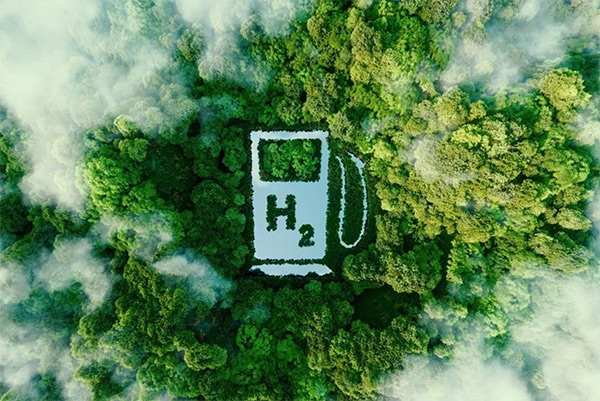A future with affordable green hydrogen would be a ‘massive breakthrough’ in clean energy with implications for industry.

By Nisar Ahamad, Vice President | Business leader – Energy, Utilities, and Chemicals | Americas Sustainability Lead Capgemini Engineering
As the planet races to establish alternatives to fossil fuels to meet net-zero targets, green hydrogen could be a powerful new form of energy production. Hydrogen has recently been referred to as a ‘Swiss Army Knife’ for reducing emissions – suggesting that a future with affordable green hydrogen would be a “massive breakthrough” in clean energy.
To say there are hurdles on the road to widespread green hydrogen adoption would be an understatement. However, if these can be surmounted, this form of energy could help to usher in a very different world.
Hydrogen’s potential use cases are vast and varied. Green hydrogen – the process of splitting water into hydrogen and oxygen with electrolyzers using 100 percent renewable energy – could be used as an alternative fuel. This could provide energy storage via fuel cells or power vehicles such as shipping vessels, trains, and air travel.
As green hydrogen is in its infancy, it’s unclear just how efficient it will be in practice for these applications. Both private sector companies and governments have expressed more than a healthy interest in exploring the field. Austria, Denmark, and China are just a few countries that have committed to major investment by launching national green hydrogen strategies.
To realize green or low carbon hydrogen’s benefits, there are barriers ahead that must be overcome. Because green hydrogen is very much in its nascent phase, much of the supply chain is under development. Concerns around efficiency, degradation, durability, resilience, density, and electrical power capacity all need to be addressed.
Among these, some of the most pressing issues are in storage and transportation. In short, to achieve workable green hydrogen-based energy, advances in technology need to be made. Compressed hydrogen storage requires a high amount of energy, while the durability of storage materials and the possibility of chemical reactions pose potential safety issues. Bulk storage in certain environmental conditions can also lead to contamination – meaning extra purification is required before it can be used, even if other storage or transportation challenges are solved.
The transportation of hydrogen, meanwhile, requires the installation of specialized pipes, along with all the accompanying costs and lead times associated with building those vast supply networks. As an added complication, the existing network of natural gas pipes can’t be used directly for hydrogen due to ‘embrittlement’, the process where metal or polyethylene pipelines are weakened, thus increasing the risk of leakages.
In short, the current hydrogen transportation pipeline infrastructure is not enough to meet future demand, and retrofitting is unrealistic with the current state of technology.
Solving these complexities also means green hydrogen will require massive investment and ‘Industry 4.0’-friendly digital infrastructure to measure, maintain, and maximize efficiencies. For industry, there are naturally boundless opportunities in the market to research, innovate, and create these systems.
Technology players also have a critical role to play in the optimization of the green hydrogen supply chain.
For a clean, safe and efficient ecosystem, the production and storage of hydrogen could be optimized with machine learning (ML). These could be integrated with demand modelling using ML insights and predictions for hydrogen production can also be used with geographic information system mapping. Together, these will earmark efficiencies and spot operational or hardware errors before they occur, therefore saving on leakage problems and repair costs.
However, even with these technical challenges, a successful green hydrogen ecosystem would have a profound impact on industry, the macroeconomic climate, and geopolitics – and, as with every major change, not all of them will be clear-cut positives.
Although there are many unknowns in green hydrogen generation, industries can expect green and low-carbon hydrogen to grow. In the pursuit of the ambitious targets for decarbonized global energy systems by 2050, the world may look like a very different – but greener – place.

Nisar Ahamad is VP and Sector Head for Energy, Utilities, and Chemicals (EUC) at Capgemini Engineering. He has over 23+ years of experience building and leading EUC, sustainability, industrial and communication businesses. Nisar has expertise in multiple engineering functions, and has supported teams in AMI (Advanced Metering Infrastructure), intelligent industry, communications (wireline, wireless 4GLTE/5G), AI/ML (Artificial Intelligence & Machine Learning) and product support services.
In this episode, I sat down with Beejan Giga, Director | Partner and Caleb Emerson, Senior Results Manager at Carpedia International. We discussed the insights behind their recent Industry Today article, “Thinking Three Moves Ahead” and together we explored how manufacturers can plan more strategically, align with their suppliers, and build the operational discipline needed to support intentional, sustainable growth. It was a conversation packed with practical perspectives on navigating a fast-changing industry landscape.